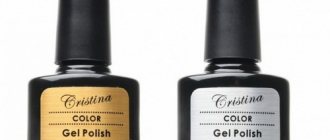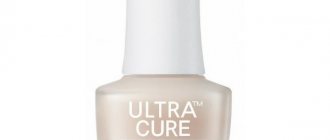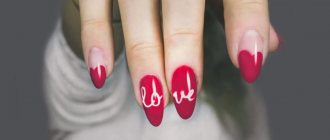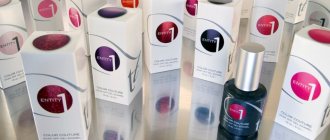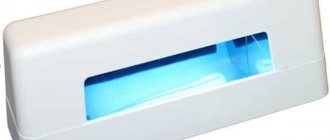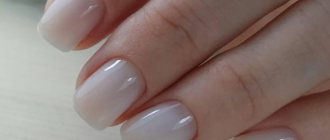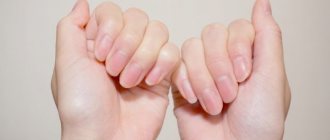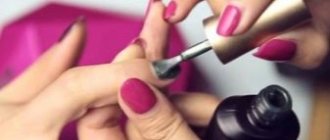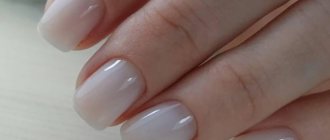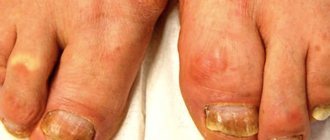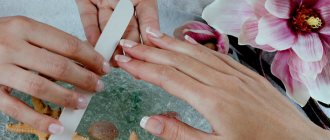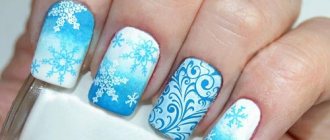What is gel polish shrinkage?
Please note that recently a manicure with straightening the nail plate has become quite popular. This allows you to eliminate unevenness and also add thickness to the natural nail, strengthening it. This option is ideal for women whose nails are very dense in nature. A thin layer of base for leveling is enough for the material to remain in place for 3 weeks.
But many are faced with the problem of the appearance of bumps, dents, and unevenness on the surface of the coating. This is shrinkage of the material, most often it appears in poorly pigmented varnishes, which need to be applied in 3 or more layers for a uniform coating. This is required so that the natural plate does not show through, while the thickness of the coating is quite dense. Accordingly, as the nail grows, bumps and indentations appear at the end of the nail or in the apex area.
Dents
Best lists
In addition to the above bases, one cannot fail to mention a couple of other wonderful tools:
- Rubber – Kodi Rubber Base.
- Camouflage – Klio Professional Base.
- Leveling – Nano professional Nanlac Gum.
Read about them below.
Rubber – Kodi Rubber Base
A long-lasting foundation with a unique hypoallergenic composition is easy to apply using a convenient brush. Dries quickly - only 2 minutes. The base stays on the nails for a long time – up to 3 weeks. In addition, Kodi Rubber Base is compatible with gel polishes from other manufacturers. Among the disadvantages is the difficulty of removing the product; you cannot do without washing it down.
Price: from 500 to 550 rub.
base for gel polish Kodi Rubber Base
Camouflage – Klio Professional Base
Klio Professional Base is not only a foundation, but also an excellent concealer. Perfectly levels the nail plate and also has a pronounced strengthening effect. With regular use, there is a significant improvement in the condition of your nails - as a result, you get healthy, long and strong nails. Compatible with products from other brands.
Price: from 650 to 700 rub.
base for gel polish Klio Professional Base
Leveling – Nano professional Nanlac Gum
Nano professional Nanlac Gum is the case when domestic products are not inferior in quality to foreign ones. The base is suitable for owners of problem nails, as it perfectly levels the surface, hiding minor imperfections on the nail plate. Included with the jar you receive a special, comfortable brush with short bristles. Does not leave detachments.
Price: from 1050 to 1100 rub.
base for gel polish Nano professional Nanlac Gum
Why does gel polish appear lumpy?
If possible, avoid light and poorly pigmented varnishes and use products that can be applied in a maximum of two layers. In this case, there will be a thin layer on the surface that will not shrink.
Features of the appearance of bumps:
- Shrinkage is often typical for plastic, rubber bases, as well as gel polishes. Most often, such bases are suitable for people with a soft nail plate on which gel polish practically does not adhere. The main way to increase the durability of a coating is to use plastic bases, which become rubbery and soft after drying in ultraviolet light.
- When pinching or bending the nail, they do not chip, but continue to sit tightly on the natural nail bed. This is ideal for clients with very thin nail plates that require strengthening. Using hard bases to level and strengthen thin and soft nails is not an option, because the material is immovable and the nail plate is soft.
- Accordingly, when the nail is compressed, this material will chip. This is a fairly common problem that often occurs among gel polish lovers. In this case, the only option to strengthen your natural nail is to use hard materials such as gel, acrylic or polygel. If you are not a fan of nail extensions, then there is no need to apply the material in a thick layer - it is enough to strengthen it with a thin layer. Any of the above materials will be suitable for these purposes. After applying gel polish to such a coating, even after a month of wear, the bumps will not be visible, due to the fact that the material is hard and does not shrink.
- Quite often this happens with popular rubber bases, which are used to level thin nail plates. Accordingly, most often such bases are more suitable for dense nails that do not bend. For soft and lifeless nails, bases of this kind can well level the nail plate and strengthen it, but will not prevent the nails from bending.
- After about one to two weeks, bumps will appear on the surface of the nail. This is due to the shrinkage of the material and its softness. Quite often this happens with ordinary low-quality transparent gels, which are sold mainly on AliExpress. We advise you to choose gels from trusted manufacturers that give minimal shrinkage.
Skols and burgs
Application errors
Gel polish often runs off the base not because it is bad, but because the artist made a mistake. As practice shows, even Chinese “flower beds” will fit well on the nail and last for a couple of weeks if everything is done correctly and a good base and top are used. The most common technology violations are the following:
Errors in applying gel polish
Applying varnish to the end of the nail plate
Thus, to avoid gel polish flowing to the end, middle or cuticle, it is enough to follow the rules and instructions. You can preview training videos on how to properly apply the coating.
Source
Ways to avoid the appearance of bumps and relief when applying gel polish
How can you tell whether the material will bulge on your nails or shrink or not? To do this, you can conduct several experiments. Take a sheet of paper with a slippery, protected coating, or regular thick polyethylene. Now apply several layers of reinforcing material. This can be a base or gel polish. Dry in a lamp, now remove from polyethylene or paper. Try bending it if the material breaks, it is quite rigid and does not shrink. Accordingly, after a while, after covering with several layers of gel polish, you will not find any bumps on it.
If the material is quite flexible, bends, and creases are observed on its surface, then the material is soft. It prolongs the wear of gel polish on very thin nails, but one of the disadvantages is the appearance of bumps and relief. This usually happens closer to correction, that is, after two to three weeks. If at the very beginning the manicure looked quite beautiful and perfectly smooth, with a clear highlight, then closer to the correction, relief, bumps, pits, and depressions appear on the surface of the nail. Most often this occurs at the junction of the free edge and the nail bed. This is due to the characteristics of nail growth.
Humps on the nails
Ways to avoid bumps:
- Using hard nail strengthening materials such as polygel and acrylic
- Use of hard Bases with highly pigmented varnishes, which can be applied in one or two layers
Accordingly, we recommend that on very thin, brittle and flexible nails, for strengthening, use not rubber bases, but harder materials that will not shrink after wearing the coating.
If you are not ready to give up leveling with a base, then we advise you to use a certain application technique, which is somewhat different from the fastest and most affordable one. The easiest way is to apply the base with a leveling layer. Initially, the nail is coated with the base using a brush and rubbing movements. Only then a large drop of the product is applied and, using a brush, it is leveled and pulled to the area of the cuticle and side ridges. After this, the nail is turned down and dried after a few seconds. This is the simplest option, which allows you to achieve perfect alignment and compaction of the nail in a few seconds.
Embossed nails
But this method has a drawback - it is absolutely not suitable for strengthening very thin and flexible nails, because a thick layer of base will shrink over time and cause bumps to appear on the nails.
Instructions for applying base on thin and bendable nails:
- To prevent this from happening, we recommend using a base with current characteristics as a substrate, that is, very liquid. The nail plate is coated with base and dried. Only after this we recommend leveling with a rubber base of a thick consistency that does not spread. We recommend increasing the drying time.
- That is, if the base dries in one minute, we recommend keeping it in the lamp for two minutes. This will prevent the material from shrinking. Is it possible to avoid the appearance of bumps by leveling with acrylic powder? The fact is that acrylic by itself, if it is without a monomer and is applied for the purpose of strengthening on a wet base, will not eliminate the appearance of relief.
- Because the base will sag along with the acrylic. This is due to the fact that the grains are not interconnected, but are only presented in the form of a suspension. For thin nails that bend under the base layer, causing the appearance of bumps, we recommend using special bases with fibers to strengthen them. They are sold not in bottles, but in large jars with a wide neck. Lints are visible inside these bases. This is nothing more than silk. It is with the help of these thin threads that it is possible to strengthen the nail and also prevent the appearance of bumps.
As for camouflage bases, they are also susceptible to the appearance of bumps on the surface. This is due to the presence of pigments in their composition. Therefore, we recommend using such bases on nails reinforced with artificial materials. That is, apply them exclusively to nails that are strengthened with polygel, acrylic or gel. This will get rid of the appearance of bumps, as well as relief during prolonged wear of the material on the nails.
Shrinkage of gel polish
The most common problems in questions and answers
French gives off a yellowish tint.
Here it is important to understand exactly when this unwanted shade appeared and what provoked it. Very often, yellowing of the gel polish jacket is observed during the drying stage of the manicure. This is caused by the proximity of the fingers to the sources of ultraviolet radiation, that is, to the light bulbs themselves inside the UV device. Conclusion: the best option for applying and polymerizing gel polish is when each nail is coated and dried separately. In any case, your thumbs should definitely not be sent to the UV lamp along with the rest, because, due to the anatomical structure of the hand, they will be positioned differently, and this means problems with drying. If yellowness appears already in the process of wearing a manicure, then it could be caused by several reasons, for example: visiting a solarium, using self-tanning products, applying coffee bean-based scrubs to the body yourself (without gloves), and so on.
In some cases, yellowing of the jacket can occur even with an excess of natural ultraviolet radiation, especially for those girls who, in pursuit of an intense tan, abuse their exposure to the sun. A similar phenomenon is observed as a result of the appearance of microcracks on the coating, invisible to the human eye. Air begins to penetrate into it, causing yellowing of the white gel polish, as well as the appearance of stains on the colored one.
The gel polish does not apply uniformly, leaving bald spots.
But you shouldn’t be afraid of this at all. The technology for applying gel polish is multi-stage and includes 3-4 mandatory decorative layers. They must be thin, so it is not unusual that the first and second coats do not achieve the required degree of density and uniformity of coverage. Two subsequent layers will successfully correct the situation.
Gel polish is too liquid.
This applies to a greater extent to coatings with a low pigment content, that is, light pastel shades. To make, for example, light pink or nude color look beautiful, you need to paint your nail several times. Often the manufacturer deliberately makes the consistency more fluid to make application easier. After all, it is very difficult to cover nails with gel polish in 3-4 layers if it is thick.
Running onto the cuticle.
This situation is most often associated with a deviation from the correct technology for working with gel polishes. Many beginners, trying to apply a decorative layer as close to the cuticle as possible, do not maintain the required one millimeter indentation. But we are talking about a gel-based coating, which expands slightly in a UV lamp and, as a result, can flow onto the cuticle and skin. Also, bleeding onto the cuticle occurs in those who try to speed up the process and paint all their nails at once, and not one at a time, as recommended by professionals. Conclusion: applying gel polish at home will turn out no less beautiful than in the salon, if you do not neglect the rules.
Gel polish wrinkles, gathers towards the center, and forms bubbles.
If the gel polish wrinkles or gathers towards the center of the nail, then most likely there is a problem with the application. The layers were not thin enough and did not have time to dry thoroughly. Conclusion: it is better to apply 3-4 thin layers than two dense ones. Take your time and work on each nail separately. If bubbles appear when applying gel polish, there is also an explanation for this. This happens when the bottle is shaken (during transportation, as a result of improper mixing of the pigment). If the gel polish has been transported, wait and let the product settle before using it. For good pigment distribution, do not shake the bottle, but lightly roll it in your palms. Such problems could also be caused by improper storage, as a result of which the product lost its original properties. Have you ever wondered why many manufacturers produce gel polish in darkened glass bottles? The fact is that this material is susceptible to ultraviolet radiation and therefore must be stored where the sun's rays do not penetrate. But here’s one secret from the professionals: when applying, do not make sudden movements with the brush, otherwise small air bubbles will also remain on the surface. Work smoothly.
Delicious recipe! Pork liver with pasta recipe with photo
Gel polish does not dry.
Too thick gel polish layers do not polymerize well, and also if the master overdid it with their quantity, trying to hide the shortcomings of unprofessional application. It would be a good idea to pay attention to ultraviolet light bulbs. Over time, they lose their original properties and therefore must be replaced regularly, at least once every three to six months (depending on the intensity of use of the device).
Another reason for poor polymerization of gel polish is that some shades, regardless of the manufacturer, tend not to dry at all (for example, there are products that do not harden in LED lamps) or are characterized by a longer drying period. No advice will help here. If you come across such a capricious product, then this is a matter of chance and there is no need to blame the seller, because he cannot predict which shade will behave this way.
By the way, very often novice masters complain that the gel polish has not dried because it feels sticky to the touch. In fact, residual stickiness is a standard phenomenon during the polymerization of these coatings. Also, one should not talk about poor polymerization if you use gel polishes with a high degree of pigment saturation (dark, very bright shades), which I paint on a napkin when removing the sticky layer. This is a variant of the norm and does not mean at all that the coating has not dried. By the way, such complaints most often arise from beginners, who complain that the pigment reaches behind the brush of the top coat and, accordingly, then gets into the bottle, spoiling the top coat itself. Experienced masters always know how to work correctly with pigmented gel polishes and apply the top coat with a different brush than the one that comes with the bottle. Sometimes a slight deviation from the technology is allowed, when the residual stickiness is removed from the pigmented gel polish before applying the top. In general, there are many subtleties and nuances, and to learn about them, you need to undergo training.
The gel polish is removed with a film and chips off.
There are many reasons for this phenomenon. It is impossible to list everything, so we present the most common ones. In some cases, masters experiment (or save money) and perform gel polish manicure using a decorative coating from one manufacturer, a base from another, and a top coat from a third. In general, they sculpt from what is at hand. And the most surprising thing is that very often such a varied “pie” wears very well. But there are exceptions. Don't want any unpleasant surprises? Then listen to the basic recommendations and do not mix products from different brands in one manicure.
Another reason for poor wear of gel polish may be that the master neglected to use a dehydrator or primer (ultrabond), limiting himself to just one thing. This is fundamentally wrong, because these tools perform completely different functions and do not replace each other. The use of a dehydrator is especially important in case of hyperhidrosis (wet hands) and after performing the classic “wet” manicure procedure. The effect of the drug is expressed in the elimination of excess moisture from the top layer of the nail plate, while the deeper layers are not affected, the water balance does not disturb, and the nails do not suffer from brittleness and drying out. As a rule, the dehydrator contains no flavorings or dyes and does not cause allergies. It is important to understand that the dehydrator removes excess moisture, and the primer (ultrabond) is responsible for adhesion of the nail plate to the decorative material. For those with naturally wet or frequently sweaty palms, it is recommended to use both a dehydrator and a primer. A third reason for chipping and peeling may be due to improper sealing of the end. This should be done at the stage of applying each layer of all coatings.
Before decorating your nails, you should not use oils and hand creams, because it is quite difficult to remove them from the surface of your nails. The traditional trimmed manicure with soaking the nails in a bath, performed immediately before applying gel polish, is also a gross violation of technology. Remember - no wet procedures associated with prolonged exposure of marigolds to water. Only dry cuticle processing, best with a milling cutter. Also, gel polish does not wear well on improperly processed nail plates (the eponychium has not been pushed back, the overgrown cuticle has not been removed), on peeling or bumpy nails, and in the presence of other problems with their health. It is impossible not to mention another reason for the poor wear of the gel polish coating, which is the use of non-acytone liquids. Let’s say that before applying gel polish, the client independently removed regular polish from her nails using such a gentle product, supplemented with oils, vitamins and various other special ingredients. Of course, the master will be able to level out most of them with a modern degreaser, but some will still penetrate deep into the nail and may well negatively affect the durability of the gel polish manicure in the future.
The gel polish coating is difficult to remove and has to be cut off.
Perhaps the master overdid it with the primer, treating the entire surface of the nail plate with it, and not the area near the cuticle, on the sides and end. By the way, in order to quickly remove gel polish, before applying a special product you need to work with a buff to remove the gloss. This is a mandatory condition and cannot be neglected. It should also be taken into account that the longer the gel polish remains on the nails, the more difficult it can be to remove. And you will certainly have to tinker if you do not immediately ensure the tightest possible fit of a napkin soaked in a special product to the entire surface of the nail plate.
Delicious recipe! Barley porridge with mushrooms in pots
Gel polish on nails is cracking.
As a rule, some owners of long manicures encounter a similar phenomenon. The fact is that the nails are constantly experiencing various loads - they get caught here, hit here, and so on. And the longer they are, the more susceptible to deformation. And even if the nail plate itself accidentally bent and did not break thanks to the gel polish, this means that it was the decorative layer that took the blow and therefore may well crack. For example, working at a computer, when you constantly tap on the keyboard with overgrown nails, is stressful and can also cause cracks. In addition, the end of the nail plate, when interacting with the surface of the keys, gradually loses the protection of the top and finish, which subsequently leads to chipping and peeling of the gel polish.
Chips and cracks are common when using topcoats without a sticky layer. These coatings have low elasticity and give the effect of glass. When bending the nail plate, a top coat without an adhesive layer may not withstand tension and crack. As a rule, such tops are intended for design and decoration.
Gel polish lasts on the nails for only a couple of days, even with strict adherence to the technology.
In fact, such cases are quite rare, but they still exist. And the reasons should be sought in the characteristics of the female body. Sometimes the problem arises due to the presence of autoimmune diseases and diseases of the central nervous system, hormonal imbalances, and the use of antibiotics and vitamins. Even simple stress can affect the durability of a manicure. Everything is very individual and it happens that a small error during application, which could go unnoticed, coincides with some processes in the body and the gel polish wears much less than usual.
Duller than the top.
The problem of top coat fading is often related to improper removal of residual stickiness, for example, using the wrong liquid. Also, you cannot remove stickiness from all nails with the same napkin; it is better to provide separate napkins for each nail or choose new areas from a common one. Do not rush and remove the stickiness immediately after drying in the lamp; it is best to do this after the top has cooled.
Why does gel polish slide off the base and apply unevenly?
Quite often it happens that after applying the base, the next layer of gel polish comes and its application becomes very inconvenient. Gel polish may apply unevenly. Most often this happens with bald spots; some types of varnish run away from the ends, as well as in the cuticle area, and it is not always possible to correct this. For manicurists, this usually does not pose any problem, since they work using the conveyor method, that is, one finger at a time. But this is a significant drawback for girls who make gel polish for themselves and want to dry all five fingers at once.
To ensure that the gel polish does not lay down with bald spots, does not spread, and does not run away from the ends, we recommend that before applying the color to the base, remove the sticky layer from it with a regular lint-free napkin. It is this sticky layer that makes application very slippery and allows the gel polish to spread. Most often, this technique is necessary before applying pastel, light colors, which are bald and lie unevenly.
Mounds
Gel polishes on Aliexpress
Below is a list of gel polishes, as well as bases, that apply perfectly in one layer. Leveling the nail plate using such varnishes will minimize the possibility of relief appearing on the surface of the nail, even after wearing the coating for a long time.
To make your first order on Aliexpress, read the instructions for registering and searching for goods, payment and delivery on the official website here, or read the article on our website “First order on Aliexpress”.
List of pigmented gel polishes that do not shrink:
- Maria ayora
- Yifuyan
- CHARM CHICA
- Azure
Beautiful nails
How to remove artificial material correctly and why is it important?
You've probably heard that gel polish spoils your nails, making them thin and brittle. It is a myth! It's not the material that ruins your nails! One of the reasons for damage to the nail plate is improper removal of the artificial coating, so this procedure must be approached with special responsibility!
Is it possible to remove gel polish yourself at home without damaging your nails? What materials and tools are needed for this? Let's figure it out.
How long can you wear gel polish?
First, let's figure out what period of wearing the coating is optimal. Often girls wear gel polish for a month, or even longer. However, they do not understand that they can damage the nail plate.
Technologists advise walking with the coating for no more than 2-3 weeks. Prolonged wear puts stress on the tip of the nail plate, its root suffers from the weight of the coating. All this can lead not only to breakage, but also to deformation of the nail plate.
How can you not remove gel polish?
RULE 1: Under no circumstances should you pick at the gel polish or tear it off the surface of the nail plate, because this can cause serious injury! If you are careless, you can remove the top layer of the nail along with the material, and this can lead to thinning and, at a minimum, painful sensations when in contact with water and various surfaces.
RULE 2: do not file away partially peeled off gel polish. In this case, you also risk cutting off the top layer of the nail and ruining it.
What other consequences might arise?
We hope these reasons are enough to convince you not to peel off the coating from the nail plate and do the gel polish removal according to the rules!
By the way, the peeling process itself is quite painful, it’s hardly worth it!
